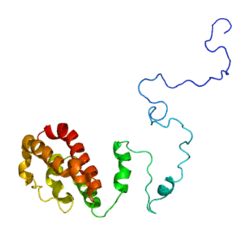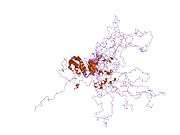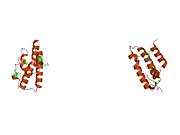Auxilin
Putative tyrosine-protein phosphatase auxilin is an enzyme that in humans is encoded by the DNAJC6 gene.[5][6][7]
Function
DNAJC6 belongs to the evolutionarily conserved DNAJ/HSP40 family of proteins, which regulate molecular chaperone activity by stimulating ATPase activity. DNAJ proteins may have up to 3 distinct domains: a conserved 70-amino acid J domain, usually at the N terminus, a glycine/phenylalanine (G/F)-rich region, and a cysteine-rich domain containing 4 motifs resembling a zinc-finger domain (Ohtsuka and Hata, 2000).[7]
Structure
The protein tyrosine phosphatase domain and C2 domain pair of auxilin, located near the N-terminus of the polypeptide, constitute a superdomain, a tandem arrangement of two or more nominally unrelated domains that form a single heritable unit.[8] The phosphatase domain belongs to the auxilin subfamily of lipid phosphatases and is predicted to be catalytically inactive.[9][10]
References
- GRCh38: Ensembl release 89: ENSG00000116675 - Ensembl, May 2017
- GRCm38: Ensembl release 89: ENSMUSG00000028528 - Ensembl, May 2017
- "Human PubMed Reference:". National Center for Biotechnology Information, U.S. National Library of Medicine.
- "Mouse PubMed Reference:". National Center for Biotechnology Information, U.S. National Library of Medicine.
- Seki N, Ohira M, Nagase T, Ishikawa K, Miyajima N, Nakajima D, Nomura N, Ohara O (October 1997). "Characterization of cDNA clones in size-fractionated cDNA libraries from human brain". DNA Research. 4 (5): 345–9. doi:10.1093/dnares/4.5.345. PMID 9455484.
- Ohtsuka K, Hata M (April 2000). "Mammalian HSP40/DNAJ homologs: cloning of novel cDNAs and a proposal for their classification and nomenclature". Cell Stress & Chaperones. 5 (2): 98–112. doi:10.1379/1466-1268(2000)005<0098:MHDHCO>2.0.CO;2. PMC 312896. PMID 11147971.
- "Entrez Gene: DNAJC6 DnaJ (Hsp40) homolog, subfamily C, member 6".
- Haynie DT, Xue B (May 2015). "Superdomains in the protein structure hierarchy: The case of PTP-C2". Protein Science. 24 (5): 874–82. doi:10.1002/pro.2664. PMC 4420535. PMID 25694109.
- "Phosphatase Subfamily Auxilin - PhosphataseWiki". phosphatome.net.
- Chen MJ, Dixon JE, Manning G (April 2017). "Genomics and evolution of protein phosphatases". Science Signaling. 10 (474): eaag1796. doi:10.1126/scisignal.aag1796. PMID 28400531.
External links
- Human DNAJC6 genome location and DNAJC6 gene details page in the UCSC Genome Browser.
Further reading
- Suzuki Y, Yamashita R, Shirota M, Sakakibara Y, Chiba J, Mizushima-Sugano J, Nakai K, Sugano S (September 2004). "Sequence comparison of human and mouse genes reveals a homologous block structure in the promoter regions". Genome Research. 14 (9): 1711–8. doi:10.1101/gr.2435604. PMC 515316. PMID 15342556.
- Scheele U, Alves J, Frank R, Duwel M, Kalthoff C, Ungewickell E (July 2003). "Molecular and functional characterization of clathrin- and AP-2-binding determinants within a disordered domain of auxilin". The Journal of Biological Chemistry. 278 (28): 25357–68. doi:10.1074/jbc.M303738200. PMID 12732633.
- Scheele U, Kalthoff C, Ungewickell E (September 2001). "Multiple interactions of auxilin 1 with clathrin and the AP-2 adaptor complex". The Journal of Biological Chemistry. 276 (39): 36131–8. doi:10.1074/jbc.M106511200. PMID 11470803.
- Ishikawa K, Nagase T, Nakajima D, Seki N, Ohira M, Miyajima N, Tanaka A, Kotani H, Nomura N, Ohara O (October 1997). "Prediction of the coding sequences of unidentified human genes. VIII. 78 new cDNA clones from brain which code for large proteins in vitro". DNA Research. 4 (5): 307–13. doi:10.1093/dnares/4.5.307. PMID 9455477.






